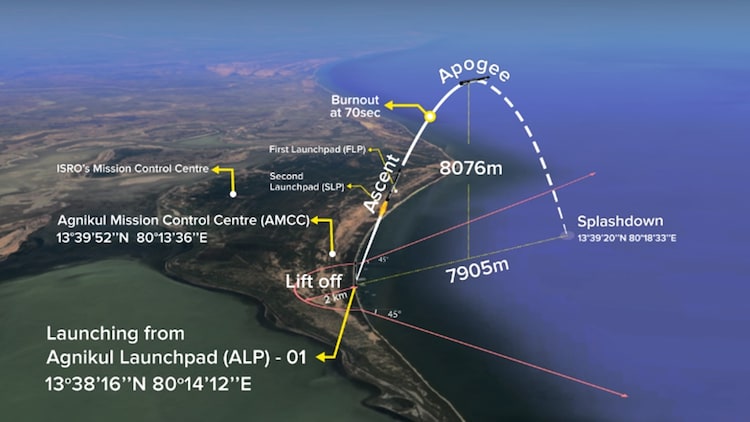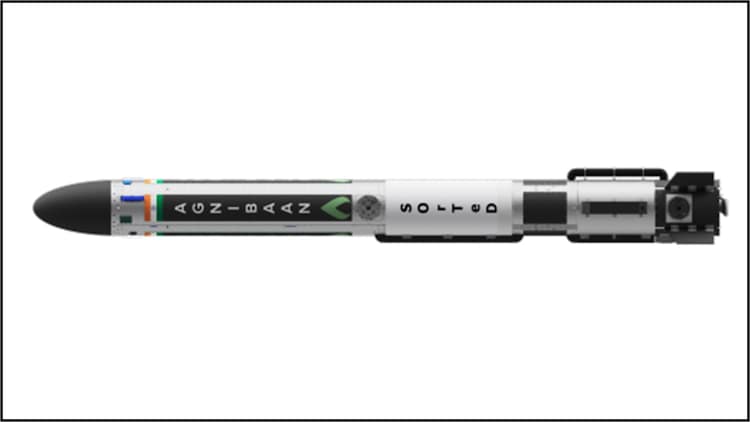
How Agnikul's two-minute-long mission could give India a new launch vehicle
Agnikul Cosmos' SOrTeD mission is a single-stage launch vehicle demonstration that will be powered by a semi-cryogenic 3D-printed engine.

In Short
- The SOrTeD mission is a single-stage launch vehicle
- The mission will feature the company's 6.2 meter-tall launch vehicle
- The company has integrated Agnibaan SOrTeD with ISRO’s key packages
Agnikul Cosmos, a private aerospace company, is all set to conduct the maiden test of its under-development launch vehicle to demonstrate the reliability of a homegrown system.
The Sub-Obital Technology Demonstrator (SOrTeD) mission will last just over two minutes, from launch to splashdown, and yet it could pave the way for the next generation of satellite launchers from the country.
The SOrTeD mission is a single-stage launch vehicle demonstration that will be powered by a semi-cryogenic engine, the Agnilet, a sub-cooled liquid oxygen-based propulsion system developed indigenously.

AGNIBAAN SORTED COMPONENTS
The mission will feature the company's 6.2 meter-tall single-stage launch vehicle with an elliptical nose cone at the top to protect the package from harsh conditions during the flight. The company has readied the vehicle with the first-ever ethernet-based avionics architecture and fully in-house developed autopilot software from India.
Powered by sub-cooled Liquid Oxygen (LOX) and Aviation Turbine Fuel (ATF), the vehicle is equipped with four carbon composite fins to provide passive control. Agnikul has said that the active pitch and yaw control will be achieved through two-plane gimbling, and together, these systems will enable controlled vertical ascent.
The company has integrated Agnibaan SOrTeD with the flight termination system developed by the Indian Space and Research Organisation (Isro), and the engine is placed in the base shroud of the rocket. The Agnilet engine is the world's first single-piece 3D-printed semi-cryogenic rocket engine.
TWO-MINUTE-LONG FLIGHT
The mission will last just over two minutes from launch to splashdown. The mission will lift off from India's first private launchpad, ALP-01, located at Satish Dhawan Space Centre in Sriharikota.
Following lift-off, the vehicle will perform a pitch-over manoeuvre nearly four seconds into flight. This manoeuvre involves the controlled rotation of the vehicle to change its orientation from vertical to a predetermined angle with respect to the ground or its flight path.
The vehicle will then go into the wind biasing manoeuvre at just over 39 seconds, which is introduced in rockets to compensate for the effects of wind on the trajectory of the rocket during ascent.
At 1 minute 29 seconds, Agnikul expects the launch vehicle to reach apogee, the point it will be farthest from the launch site before it splashes down at just over two minutes into flight, marking the completion of the mission.
WHY JUST TWO MINUTES?
While the flight is brief, the data that it will provide will help engineers fine-tune and shape the development of the Agnibaan launch vehicle, which is expected to be flexible when it comes to launching missions.
"The inaugural flight of Agnibaan SOrTeD, Mission-01, serves as a test flight, gathering crucial flight data and ensuring optimal functioning of systems for Agnikul's orbital launch vehicle, the ‘Agnibaan," Agnikul Cosmos said.
The company is targeting the multi-billion dollar small satellite launch market, which is looking for a launch vehicle with quick turnaround times and the ability to launch at a faster pace.
The maiden test flight on Friday will determine the future course of development of the launch vehicle, which is aimed at making India a hub of small satellite launches.

